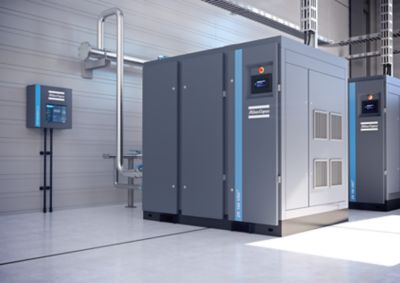How does a desiccant air dryer work?
Twin tower desiccant air dryer working principle
Adsorption dryers are used when the compressed air application requires a pressure dew point below 0°. The regenerative desiccant dryers consist of two pressure vessels. Both vessels are filled with desiccant. One vessel is removing moisture from the compressed air.
Wet air passes directly through the desiccant bed which adsorbs the moisture. When this vessel is saturated with moisture the valves will switch and lead the air to the other standby vessel. During adsorption in the other vessel, the first vessel will be regenerated. It's a cyclic process.
The desiccant medium has a finite capacity for adsorbing moisture before it must be dried out, or regenerated. To do this, the tower containing saturated desiccant medium is depressurized and the accumulated water is driven off.
How this happens depends on the type of dryer.
- Heatless dryers use only compressed air as a purge
- Blower purge dryers use a combination of air from an external blower, heat, and minimal compressed air
- Blower zero purge dryers use a combination of air from an external blower, heat, and zero compressed air
- Heat of compression dryers use the heat of the compression
- Heated purge dryers use heat and small amount of compressed air
Types of desiccants
Depending on the technology and dew point requirement, there is always the best choice of desiccant, sometimes a combination of multiple layers of desiccants used in our designs. In this way, we will ensure required PDP levels and maximized lifetime for desiccant.
Activated Alumina grade D
Premium quality desiccant, long lifetime, few dust forming
High performance silicagel
Premium quality desiccant, long lifetime, few dust forming
Cerades™: a groundbreaking desiccant
Some Atlas Copco innovations change everything. Cerades™, the first ever solid desiccant, has revolutionized adsorption dryer design, efficiency and performance. And that makes all the difference for you as you enjoy better air quality, lower energy and service costs, and health and environmental benefits.
Water resistant silica gel
15% extra capacity to cope with aging, resistance against free water, limited dust forming
Rotary drum dryer working principle
structured desiccant rotary drum dryer
The rotary drum dryer also uses adsorption technology. The desiccant does not come in granular form. Instead, it is bonded with a binding material in a honeycomb structure. The main advantages are:
- No erosion of desiccant beads
- No escape of beads
This unique technology does not require any additional energy, as it is using the heat of compression. The rotating drum is divided into sections. In general 3/4 of the drum is used for adsorption, while 1/4 is used for regeneration. It's a continuous process as the drum rotates and therefore doesn't require any switching valves.


